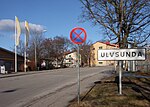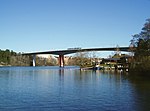Stora mossen metro station

Stora Mossen metro station is a station on the Green line of the Stockholm metro. It is located on the border between the districts of Ulvsunda and Stora mossen, which are part of the borough of Bromma in the west of the city of Stockholm. The station is on an embankment and has a single island platform, with access from a pedestrian subway under the line linking Drottningholmsvägen and Stora Mossens Backe. The distance to Slussen is 9 km (5.6 mi).The station lies on the route of a line known as the Ängbybanan that formerly linked Alvik and Islandstorget. The Ängbybanan was designed and built for use by the future metro, but was operated from 1944 as part of line 11 of the Stockholm tramway. Stora mossen station was inaugurated as part of the metro on 26 October 1952 with the conversion of the Ängbybanan and its extension to form the metro line between Hötorget and Vällingby.
Excerpt from the Wikipedia article Stora mossen metro station (License: CC BY-SA 3.0, Authors, Images).Stora mossen metro station
Drottningholmsvägen, Stockholm Ulvsunda (Bromma stadsdelsområde)
Geographical coordinates (GPS) Address Nearby Places Show on map
Geographical coordinates (GPS)
| Latitude | Longitude |
|---|---|
| N 59.334722222222 ° | E 17.965 ° |
Address
Drottningholmsvägen
Drottningholmsvägen
167 31 Stockholm, Ulvsunda (Bromma stadsdelsområde)
Sweden
Open on Google Maps










